Laptop Mag Verdict
With its large display, improved pen features and epic battery life, the Samsung Galaxy Note II for Verizon continues to be the gold standard for big-screen phones.
Pros
- +
Large display with sharp details and bright colors
- +
Epic battery life
- +
Useful pen features
- +
Dual-view multitasking option
- +
Strong graphics and performance
- +
Blistering 4G LTE speed
- +
Fast camera
Cons
- -
Size can be overwhelming
- -
Display dimmer than competing phones
- -
Design has unnecessary logos
Why you can trust Laptop Mag
Better late than never. Completing its conquest of the Big Four, the Samsung Galaxy Note II has finally landed on Verizon Wireless. The phone has the same ginormous 5.5-inch display, enhanced pen features and quad-core processor that we've come to love, but now has the benefit of Verizon's widespread 4G LTE network. However, the Note II also has a supersized price of $299. As you're about to find out, the premium is well worth it.
Editors' Note: Portions of this review were taken from earlier reviews of the Galaxy Note II.
Design
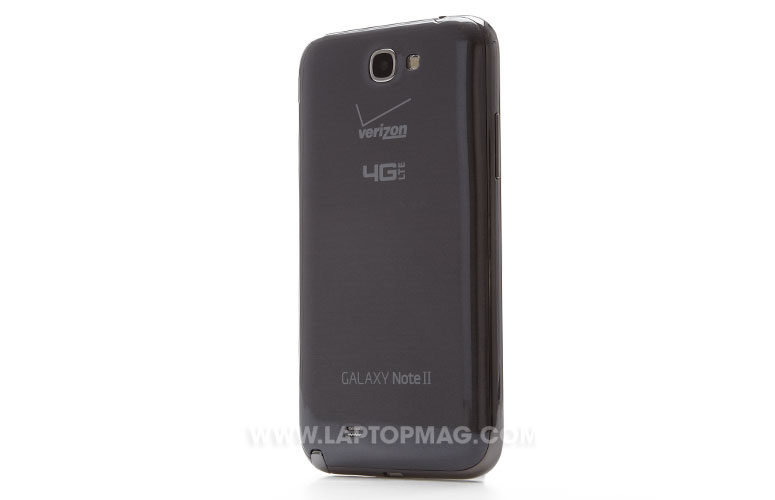
Click to EnlargeThe second-generation Note features the same rounded curves and glossy polycarbonate chassis as the Samsung Galaxy S III and comes in Titanium Gray and Marble White. We really like the subtle striations along the rear panel, which catch the light and add some depth. Also on the back is a chrome-lined 8 megapixel camera, an LED flash and the speaker.
Verizon goes a little overboard with logos on the Galaxy Note II. Sprint only includes a logo for the Galaxy Note II itself on the bottom part of the back cover. Meanwhile, AT&T complements that logo with a subtle AT&T logo on the top part of the back. Verizon's Note II has three logos on the back (Verizon, 4G LTE and Galaxy Note II) and even a little Verizon logo on the home button up front. It's nearly the smartphone equivalent of a race car.
A positively enormous 5.5-inch display occupies the majority of the front. There's just enough space for the 1.9 megapixel front-facing camera and Samsung logo at the top. On the bottom, a pair of capacitive buttons flank the home button. A thick band of dark gray chrome wraps around the sides of the device.
A power button sits on the right of the Note II, the volume rocker is on the left, and the headphone jack is on the top. The bottom of the Note II houses the microUSB port and a dock for the S Pen.
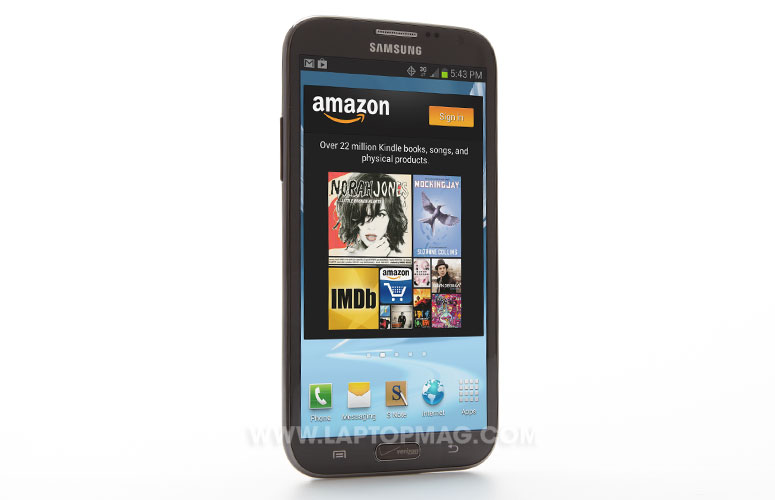
Click to EnlargeMeasuring 5.9 x 3.2 x 0.37 inches, the Galaxy Note II is taller than the original Galaxy Note (5.8 x 3.27 x 0.38 inches), but manages to be thinner and narrower. The new dimensions enabled us to operate the phone one-handed, albeit with some difficulty. The fact that there's a "One-handed operation" menu in Settings shows that Samsung is aware of the issue, too.
The Note II weighs in at 6.4 ounces, which is significantly heavier than the 5.93-ounce LG Intuition. The HTC Droid DNA cuts a sleeker profile at 5 ounces, 5.5 x 2.7 x 0.38 inches. Bottom line: The Note II is called a phablet for a reason. You'll have to consider how much of a device you're willing to carry in exchange for all of it's versatility.
Display and Audio
The Note II's 5.5-inch, 1280 x 720 display is a step down from the Note's 1280 x 800 display. However, what it lost in resolution, it more than makes up in overall real estate.

Click to EnlargeThe high-definition trailer of "The Hobbit" looked gorgeous with sprawling green landscapes and crisp snow white mountaintops. In a close up shot of Gandolf, the wizard's wrinkles were well-defined, particularly beneath his eyes. There was a hint of pixelation during darker scenes such as Gollum's cave.
The brightness left a lot to be desired. While it matched its predecessor, the Note II's 240 lux display brightness fell below the Android phone category average (299 lux). The Droid DNA measured 311 lux, while the Motorola RAZR Maxx HD delivered a dazzling 467 lux.
Audio from the Note II's twin speakers were impressive. As we listened to Selena Gomez's "Love You Like a Love Song," we heard crisp clear highs and full mids. The bassline sounded slightly muted.
Software and Interface
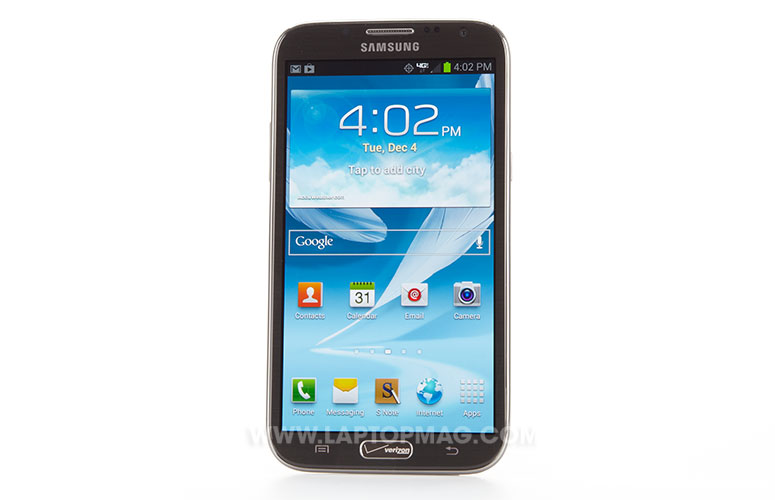
Click to EnlargeThe Note II features the Android 4.1 Jelly Bean OS combined with Samsung's TouchWiz interface, which means you get great features such as Google Now and offline voice typing. However, Samsung continues to innovate, adding features to Google's OS.
The notification menu now features a brightness control slider in addition to shortcuts for Airplane Mode, GPS, Screen rotation and more. However, Verizon removed the Wi-Fi button for an "Ongoing" notification. While it's nice that you can see what network you're connected to, it would be far more useful to simply toggle Wi-Fi on or off. Still, the dedicated number row above the letters on Samsung's touch keyboard is a big addition. (No more toggling!)
The Note II includes seven customizable home screens, with the time and weather widget front and center. Touch the Google search box and you'll be brought to Google Now, which learns from your searches to present handy info at a glance. For example, Google Now can show you how long it's going to take you to get home based on the traffic, the latest score from your favorite teams and whether your plane is on time. Again, though, Verizon removed two of Samsung's widgets, S-Cloud and S-Planner.
The lock screen on the Note II not only lets you customize shortcuts to different apps, but also displays a news ticker at the bottom of the screen. You can even scribble a quick note by double-tapping the screen with the S Pen while holding down its button.
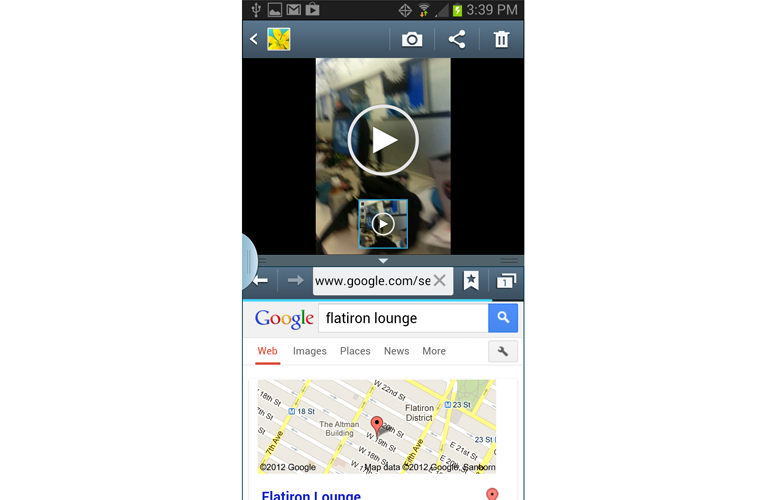
Click to EnlargeOther notable features include Popup Video for watching clips while you use other apps, and you can now resize the window. There's also a new Popup Browser option that enables Note II users to view a Web page (say, in an email) without leaving the Email app.
S Voice hasn't changed since we reviewed the Galaxy S III. It's functional, but Apple's Siri is just smarter. When we asked S Voice for a five-day forecast, we got just the current conditions. You're probably better off using Google Voice Search. It's not as feature-rich, but it's faster and less prone to network errors.
Motions and Sharing
The Note II includes a bunch of clever motion-sensitive gestures, from Direct Call (dialing a contact displayed on screen by bringing the phone up to your ear) to double-tapping the top of the phone to go to the top of a list (like your inbox). A slick new feature called Quick Glance displays alerts when you wave your hand over the camera with the screen off, but it only shows the number of missed calls, emails and your battery life status.
As you might expect, the Note II borrows all of the sharing features from the S III, including S Beam for sharing photos, videos and other files between two Galaxy devices with a tap. And because S Beam leverages NFC for the handshake and uses Wi-Fi for beaming files, transfers are fast.
Multi-Windows Multitasking
The Note II lets you switch between apps by long-pressing the home button to see the recent app menu. But there's a Multi-Window feature you won't find on any other Android phone that takes multitasking to the next level.
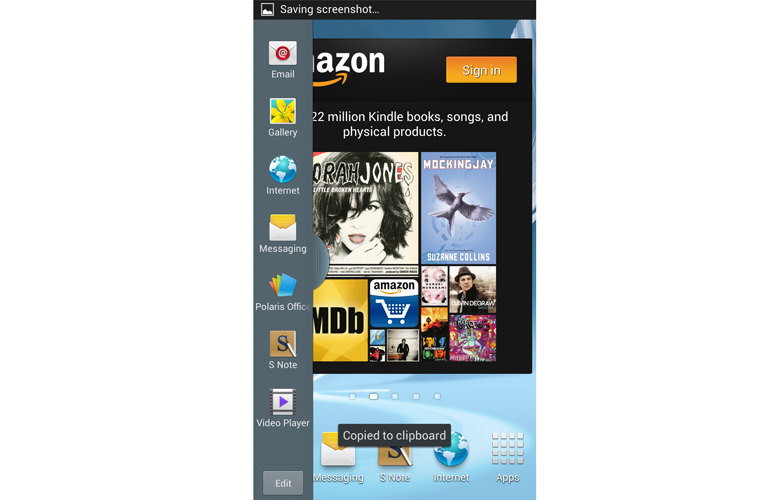
Click to EnlargeLong-pressing on the back button reveals a tab on the left side of the screen. Swipe it open to reveal shortcuts to seven apps you can drag onto the main screen (from Messaging and Email to Polaris Office and Video Player). Once you drag a second app over to the right, you'll see a split-screen showing both apps running at once. We noticed that Verizon's version doesn't support Google apps (Gmail, Chrome and Maps, among others). The unlocked version of the Note II (GT-N7100) features 12 shortcuts while the Sprint edition has 11. However, Verizon said it will issue an update that will add support for these apps.
We tested the feature by running the email app up top and Facebook on the bottom, so we could periodically check social updates as we returned messages. Flipping the Note II to landscape mode displayed the apps side by side, and just like the Galaxy Note 10.1, we could resize the windows for the two apps or swap their positions.
In the future, we'd like to see apps interact with each other in this mode. For example, it would be great to be able to drag and drop a photo from the Gallery into an outgoing email or Facebook post. But overall, Samsung has done an admirable job taking full advantage of the Note II's big screen.
S Pen
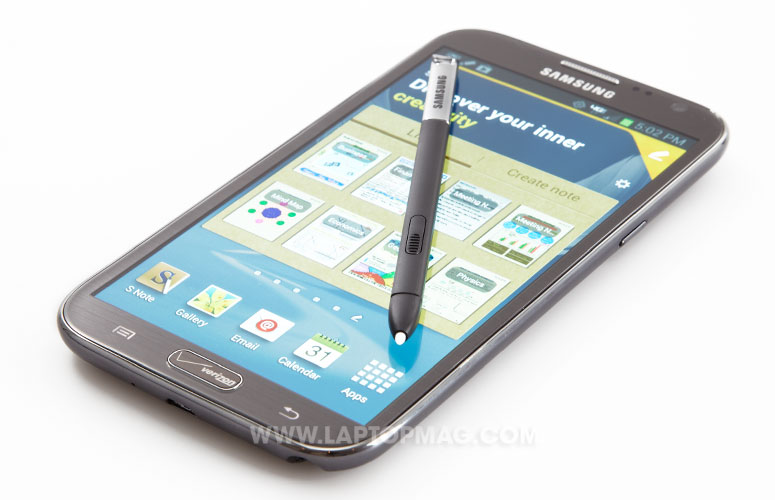
Click to EnlargeThanks to a new pen design and the same Wacom digitizer used inside the Galaxy Note 10.1, the Note II offers a vastly superior pen input experience compared with the original Note. There's no lag when writing, and the flatter and larger pen feels more ergonomic, complete with a textured button for performing shortcuts. Having 1,024 levels of sensitivity makes for a smoother experience and gives users a lot more control when using drawing apps.
Samsung helps you get started with the S Pen by automatically launching a special home screen when you take the stylus out of its slot that displays your most recent notes and templates for starting a new one. (You can turn this setting off.)
Like the Note 10.1, the S Note app itself is smart enough to create crisp shapes from your sketches and even look up formulas. In addition, handwriting recognition has improved. You can choose from a Palm Pilot-like window on the bottom of the screen or let the Note II translate on the fly. Annoyingly, the S Note app often doesn't insert a space between words, so we mostly stuck with handwritten notes. At least palm rejection is no longer an issue.
Samsung has found clever new ways to leverage pen input beyond digital ink. The Air View feature lets you hover the S Pen over content to preview it, whether it's the first sentence of an email or photos in the Gallery app. We especially like how you can skim through a video in the timeline via Air View.
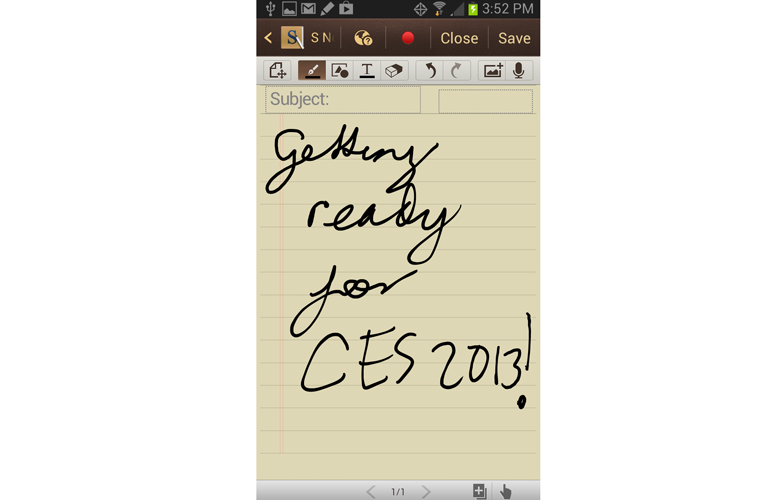
Click to EnlargeAfter a while, we actually enjoyed navigating the Note II with a pen, though sometimes we had to repeat our taps. We also wish the pen worked with the back and menu buttons beneath the screen; you have to use your finger.
So what about pen-enabled apps? The collection is growing, but there's not a ton to write home about. The bundled Paper Artist app on our Note II lets us import photos to create sketches, and we found SignDoc Mobile (for signing documents) and OmniSketch under the Best S Pen Apps section of the Samsung Apps store.
The fact that these were the only two choices listed is pretty sad, but there are others available in the Google Play store. TouchRetouch, for example, helps remove unwanted objects for photos. There's also Zen Brush and OmniSketch for aspiring artists, iAnnotate PDF for annotating PDFs and Touchnote Postcards for sending personalized postcards.
Samsung Tec Tiles and Accessories
Just like the S III, the NFC-enabled Note II can use Samung's TecTile Tags. Available in $15 packs of five, TecTiles let you toggle all sorts of settings or perform certain actions with a single tap. After downloading the free, newly updated TecTile 3.0 app, it's a cinch to program what you want the device to do once it comes close to a TecTile sticker. Users can engage silent mode, Bluetooth or set their alarms.
TecTiles can also be used in group settings, allowing each user to activate his or own unique profiles. We created private tags specific to our device. The app also keeps a log of all your created tags for a quick, easy-to-access reference. If you have a household with other NFC-capable Android phones, TecTiles should work with those, too.
Taking a page from the iPad's playbook, Samsung sells an optional flip cover (in Navy or Brown, $29.99), which replaces the phone's rear cover, but incorporates a leather flap to protect the screen.
Performance
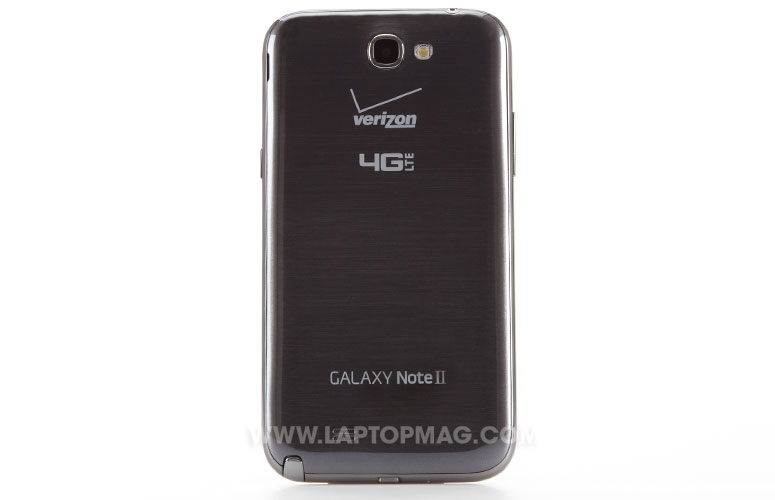
Click to EnlargeAs one of the first quad-core phones in the U.S., the Note II's 1.6-GHz Exynos processor is plenty powerful. We did notice some lag after hitting the home button, but as with the Galaxy S III, disabling the S Voice shortcut for this key sped things up.
To truly appreciate the power of the Note II, you need to play demanding 3D games. We tried "Dead Trigger," a zombie-shooting title, and animations were fluid, even with multiple baddies on the ginormous screen. We also appreciated fine details such as the divots put in stone walls from our wayward bullets.
The Note II delivered a strong performance during our benchmark testing, scoring 4,451 on Benchmark CPU, topping the 3,035 Android average. Still, it wasn't enough to beat the 1.5-GHz quad-core Snapdragon S4 CPU-powered HTC Droid DNA (4,752) or the Motorola RAZR Maxx HD (5,161). On the An3DBench graphics test, the Note II delivered a score of 7,589, surpassing the 7,171 average, the DNA (7,337) and the RAZR Maxx HD (7,261).
When we ran Quadrant, which measures CPU, graphics and I/O performance, the Note II scored 6,221. That's nearly double the 3,280 category average. The RAZR Maxx HD managed 4,971, but the DNA scored a more impressive 7,011.
The Samsung Galaxy Note II comes with 16GB of storage, which can be expanded to 64GB via the microSD slot.
4G LTE and Web Browsing
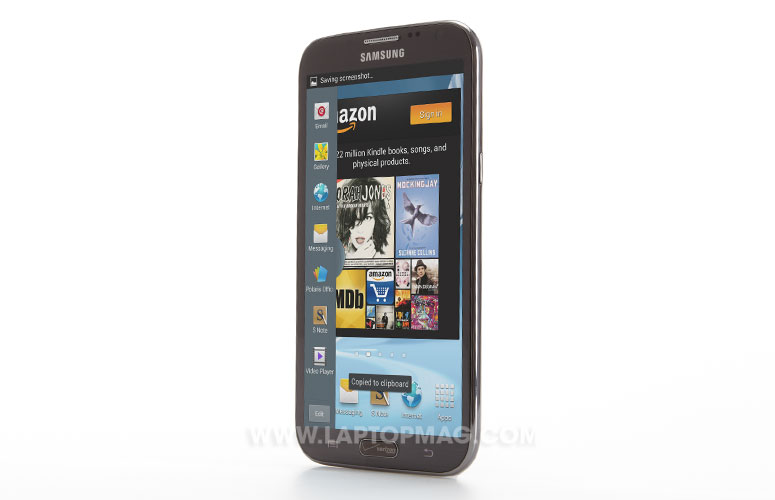
Click to EnlargeThe Note II offered reliably swift speeds on Verizon's 4G LTE network, which is available in 440 markets and counting. On Speedtest.net, the Samsung Galaxy Note II delivered an average download speed of 10.5 Mbps with an average upload speed of 7.6 Mbps. The mobile versions of CNN.com, NYTimes.com and ESPN.com loaded in 2.3, 2.6 and 3.7 seconds, respectively. The desktop version of Laptopmag.com loaded in a swift 6.6 seconds.
Web browsing on the Note II is pretty similar to the S III. The default Web browser is present for normal surfing, but Samsung includes a popup browser to quickly check out links in apps like Email so you don't have to leave the app. Users can expand the mini browser to full screen, but it can't be used for downloading.
Apps
On the Samsung front, there's Kies air and AllShare Play for file and media sharing, Music Hub and Music Player. There's also the S Suggest app store in case you can't find anything in the Google Play store. Samsung has also added Group Cast, which lets groups of people share photos, music and documents in real-time, provided they're on the same Wi-Fi network.
Verizon has added theusual cast of carrierware, including My Verizon Mobile, VZ Navigator, NFL Mobile and Viewdini, which came in handy for catching up on back episodes of "Sons of Anarchy." Third-party apps include Amazon, YouTube, IMDb, Zappos, Polaris Office 4.0 and Audible.
Camera and Camcorder

Click to EnlargeThe Galaxy Note II's 8-megapixel camera is not only fast, but also capable of taking striking photos. One shot we took of bunches of spinach had a fantastic level of detail, right down to the delicate veins and ridges on the leaves. Indoors, an image taken of our dog, Xerxes, captured all his fine hairs, but we did notice a white haze in the background. We encountered this issue with the Galaxy S III, too.
Like the S III, the Galaxy Note II includes a bevy of camera settings you can tweak and multiple shooting modes, including Panorama. There's also Share Shot, for broadcasting pictures via Wi-Fi to nearby Galaxy devices with the same feature. Buddy Photo Share continues to recognize friends and family in the frame to quickly connect with them via email, phone and social networks.
The most amazing feature of the Note II's camera is the Best Faces mode, which takes a series of shots and lets you choose the best-looking mug for everyone in the frame. Magically, the Note II then combines all of the individual faces into one shot. Even when we zoomed into the finished photo, we couldn't tell that the original image had been modified.
We tested the Note II's 1080p camcorder by shooting New York City traffic. Everything from the reflections on moving vehicles to the brick work in buildings looked highly detailed, and there was no hitching. The sensitive mic picked up squeaky breaks and voices on the street.
Battery Life
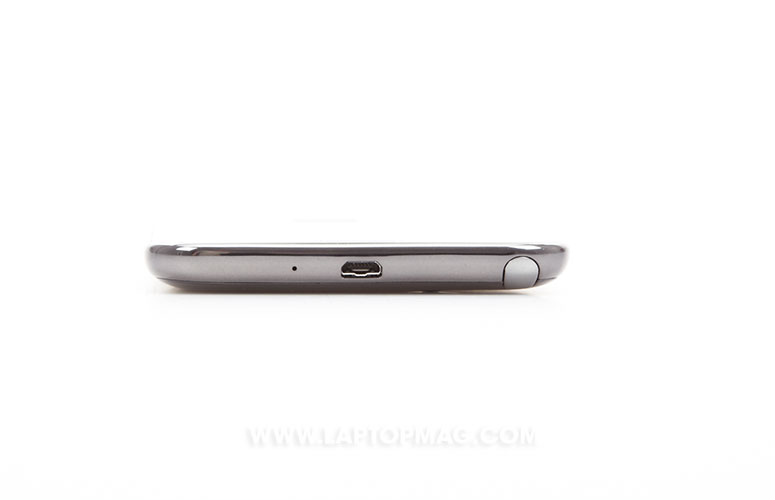
Click to EnlargeGiven that other versions of the Note II lasted more than 9 hours on the LAPTOP Battery Test (continuous Web surfing over 4G on 40 percent brightness, we expected lots of endurance from the Verizon model, too. This phablet did not disappoint. The Note II's 3100 mAh Li-Ion battery lasted an epic 10 hours and 6 minutes. That's about 4 hours longer than the 6:02 Android smartphone average. The Motorola RAZR Maxx HD, by comparison, lasted 8:13, and the HTC Droid DNA lasted 6:29. The AT&T (9:27) and Sprint (9:51) versions of the Note II weren't far behind, while the T-Mobile Note II lasted 10:12.
Call Quality
Test calls made to landlines and cellphones in New York, New Jersey and California were clear on both ends. However, we noticed a slight echo when we switched over to speakerphone.
Verdict
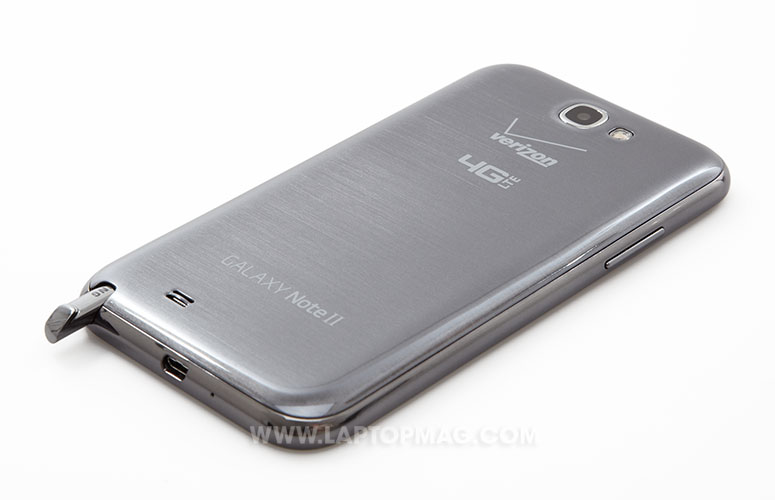
Click to EnlargeFrom its huge 5.5-inch display to the improved S Pen and fast quad-core CPU, Samsung took everything we loved about the original Note and supersized it while providing the longest battery life you can get on a 4G LTE phone. The Multi-Window multitasking feature is yet another reason to get this Android handset. Not everyone will want to spend $299 or use a 5.5-inch phone, but those who like the idea of a carrying big-screen device should look no further than the innovative, powerful Galaxy Note II.
- 10 Hottest Holiday Smartphones
- HTC Windows Phone 8X (Verizon) Review
- Smartphone Buyers' Guide
Samsung Galaxy Note II (Verizon) Specs
| Audio formats supported | AAC, FLAC, EVRC, eAAC+, AMR-WB, QCELP, AMR-NB, OGG, AAC+, MIDI |
| Bluetooth Type | Bluetooth 4.0 |
| Brand | Samsung |
| CPU | 1.6GHz Exynos Quad-Core Processor |
| Camera Resolution | 8 MP |
| Carrier | Verizon |
| Company Website | http://www.samsung.com |
| Data | CDMA, LTE, EV-DO Rev. 0, 1xRTT |
| Display (main) | 5.5 inches |
| Form Factor | Candybar Touchscreen |
| Front Camera Resolution | 1.9MP |
| Internal Memory | 16GB |
| Memory Expansion Type | microSD Card |
| Operating System | Android 4.1 |
| Ports | microUSB, 3.5mm headphone |
| RAM | 2GB |
| Size | 5.94 x 3.16 x 0.37 inches |
| Talk / Standby Time | up to 22 hours/up to 250 hours |
| Video formats supported | VC-1, MPEG-4, H.264, H.263, VP8 |
| Weight | 6.4 ounces |
| Wi-Fi | 802.11 a/b/g/n |

Sherri L. Smith has been cranking out product reviews for Laptopmag.com since 2011. In that time, she's reviewed more than her share of laptops, tablets, smartphones and everything in between. The resident gamer and audio junkie, Sherri was previously a managing editor for Black Web 2.0 and contributed to BET.Com and Popgadget.
